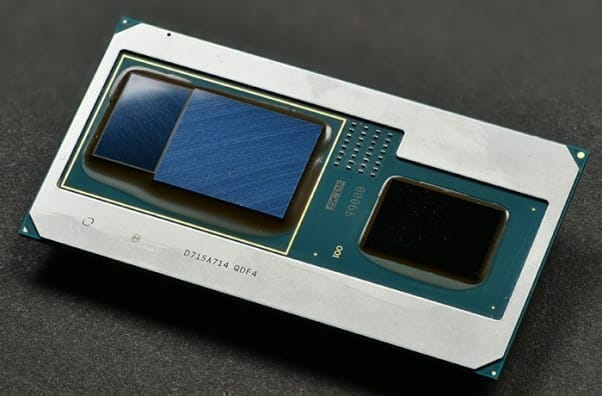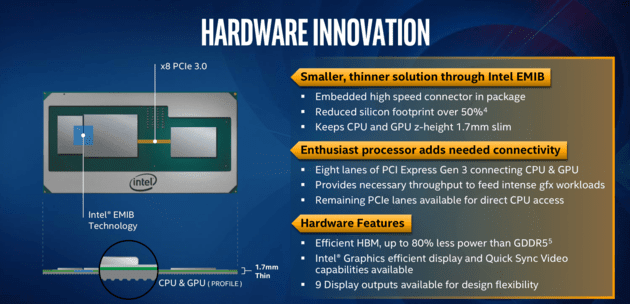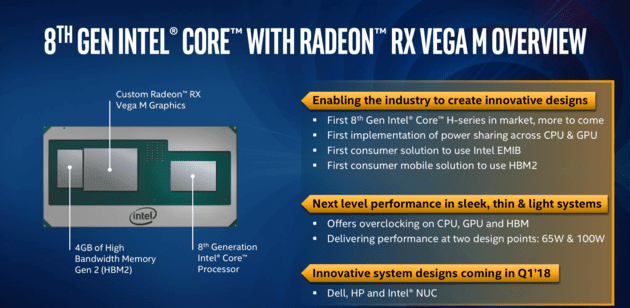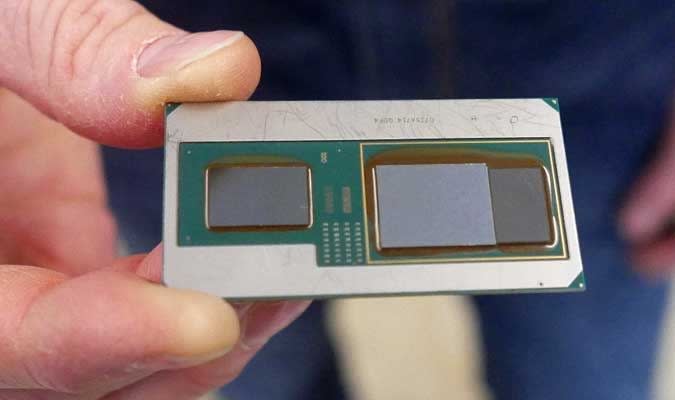Intel finally launches Kaby Lake-G, one of the most innovative step in years. These CPUs have built-in AMD’s Vega GPU and HBM2 memory, making it a single multi-chip package. Intel is releasing only five models for laptops at the beginning of New Year. NUCs (Next Unit Computing) are expected in first quarter – TNM.

Last week at press briefing, the manufacturer said “Vega had everything that Intel needed“, and the result is one of the most interesting Intel product in years.
As we explained before that the alphabet G stands for gaming. In Kaby Lake-G, Vega M GPU and HBM2 memory lying next to CPU is truly innovative but technical results are not revealed yet.
Intel Kaby Lake-G Technical Features:

Intel launches 5 of Kaby Lake-G processors with two different Vega M graphic solutions behind. The Radeon RX Vega M GH and Radeon RX Vega M GL. GH stands for “Graphic High” and GL for “Graphics Low“. GH models have 24 CUs (Compute Units) and higher clock rate with a TDP of 100 watts. And GL models have 20 CUs and slightly less clock rate but this entire chip runs at only 65 watts. Below is in-detail chart of the difference between two.
| Graphics Unit | Radeon RX Vega M GH | Radeon RX Vega M GL |
|---|---|---|
| Architecture | Vega M | Vega M |
| Compute Units | 24 | 20 |
| Stream processors | 1536 | 1280 |
| Base GPU Clock | 1,063 MHz | 931 MHz |
| Boost GPU Clock | 1,190 MHz | 1,011 MHz |
| Storage | 4 GB HBM2 | 4 GB HBM2 |
| Memory clock | 800 MHz | 700 MHz |
| Memory Bandwidth | 204.8 GB / s | 179.2 GB / s |
| Peak SP performance | Max. 3.7 TFLOPS | Max. 2.6 TFLOPS |
| ROPs | 64 pix / clk | 32 pix / clk |
Intel Kaby Lake-G Processor with Radeon RX Vega M Graphics

All these CPUs are also going to have Intel graphics, so Intel HD 630 will be included with Quick Sync features. With two different models having TDP of 100 Watts and 65 Watts, it is not a right way to compare them to each other, but clock rate remains almost same. So, many are going to prefer battery timing over slight increase in performance. Here is the list in detail of all models available.
| Model | i7-8809G | i7-8709G | i7-8706G | i7-8705G | i5-8305G |
|---|---|---|---|---|---|
| Base Rate | 3.1 | 3.1 | 3.1 | 3.1 | 2.8 |
| Max. Turbo clock | 4.2 | 4.1 | 4.1 | 4.1 | 3.8 |
| Cores / threads | 4.8 | 4.8 | 4.8 | 4.8 | 4.8 |
| L3 cache | 8th | 8th | 8th | 8th | 6 |
| Memory channels | 2 | 2 | 2 | 2 | 2 |
| Memory type | DDR4-2400 | DDR4-2400 | DDR4-2400 | DDR4-2400 | DDR4-2400 |
| Unlocked | Yes | No | No | No | No |
| Intel HD Graphics | 630 | 630 | 630 | 630 | 630 |
| Graphics clock (Max) | 1100 MHz | 1100 MHz | 1100 MHz | 1100 MHz | 1100 MHz |
| Discrete graphics | Vega M GH | Vega M GH | Vega M GL | Vega M GL | Vega M GL |
| Intel vPro Technology | No | No | Yes | No | No |
| Package Type | BGA | BGA | BGA | BGA | BGA |
| TDP | 100W | 100W | 65 W | 65 W | 65 W |
Intel is confident, however a Lot of us are waiting for hands-on experience and real analytic charts between them. Till then nothing can be said for sure and real benchmarks are going to tell us the potential of these CPUs.

